Day 4: Colletorto
When we open the electric powered window blinds this morning at about 8 am, the balcony is wet and the sky is overcast. It had rained overnight and, although it isn't raining when we get up, we wonder how it will affect the plans to pick olives.
After breakfast--a very nice spread of pastries, rolls, ham, yogurt, fruit and cakes--the weather appears to be improving. Luigi tells us that the plan is to wait for for a couple of hours for the fields to dry off...not only to avoid soggy ground but because picking when the trees are wet could damage them. While we wait, we walk up to the main street of the "village". In fact, Colletorto is more than a small village but is really a small town (certainly larger than Pienza). There are shops lining the main street and houses climb up the hill above the town and also down below the "centro". In the light of day, we notice two things that we had missed when we arrived last night. There is wooden and iron scaffolding supporting many of the buildings in town and there are a number of "temporary" buildings (large trailers) which house stores, bars and other shops. We find out that Colletorto is two miles from the town of San Giuliano di Puglia where 26 schoolchildren died in an earthquake just four years ago and, while there was no one killed in Colletorto, there was extensive damage that is still not repaired.
We stroll up and down the main street and into the old section with narrow lanes and a lot more scaffolding. We pass the very attractive city hall (municipio) with its open courtyard and the tall round medieval stone tower--the Torre Angioina--which seems to be closed for repairs. The hills surrounding the town are covered with olive trees--the main crop of Colletorto--and. across the valley, we can also see the town of San Giuliano di Puglia and "temporary" town of new wooden buildings close by. After our walk through town--there are groups of older men congregated on the street but very few women are out--the sun seems to be trying to break through and Luigi tells us that we will wait another hour and head to the fields at 11 am. We take the opportunity to drive over to San Giuliano di Puglia and see what we can see. We see a large number of construction vehicles along the road and several new houses being built on the hillsides between the two towns. The landscape looks quite stark and rugged....very brown and pretty steep.
The road into the village of San Giuliano is closed but we continue on to the temporary town....it is quite extensive with rows of nice wooden buildings for housing, a school, a commercial center and a large athletic field. The Molise regional elections are next week and election posters are plastered everywhere. We are surprised to see lines of television trucks from the Italian networks parked next to the town center and crowds of men in suits and in uniforms, but we don't have time to stop and find out what's going on.
By 11 am, the sun is out, the sky is blue and the temperature is very pleasant (in the low 70s). The group of 25 "workers" all walk together to the fields on the edge of Colletorto...the "weekender" participants are augmented by Luigi's sisters who usually return to Colletorto for the olive picking. Some of the participants have been coming back every year - others are newcomers, like us. They hail from Scotland, England and Wales, and are mostly colleagues and friends of Luigi, and then also friends of friends. One couple is here with two young boys. There are architects, educators, a fireman, an events planner - folks who are taking a break from their mostly high-pressured jobs to experience something altogether different in a very remote, beautiful spot. The equipment and a trailer full of refreshments are waiting for us, as well as the owner of the trees, and we get a quick orientation to our "jobs". In Molise, most olives are picked by hand because the fields are on hillsides and it is impossible to use mechanical equipment for the job. They also feel that the machines damage the trees. Large green nets are spread under the trees and pickers are armed with orange hand rakes (almost like large plastic combs). Some people climb ladders and other stay on the ground; the technique is to "comb" the olives off of the branches. They fall onto the netting and when the tree is finished, the olives are collected into bags and taken to the "frantoio". There is no need to discriminate between green and black olives....they are all mixed together. Leaves and twigs will also get separated out at the frantoio. When a tree is finished and the olives are bagged, the nets are moved over to another tree. Depending on the size of one's holdings, olives will be picked through November, with the frantoios running 24-7.
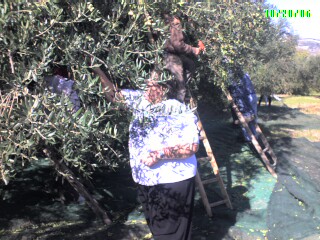
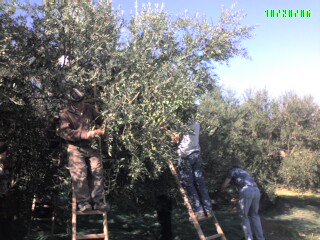
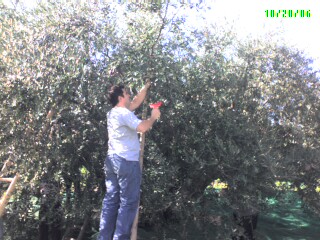
The work is not particularly onerous when the olives are at face level or below but when you have to reach above your head for branches, it can get tiring. Some of the "workers" spend time "guarding" the refreshment trailer and handing out drinks to those who are picking.
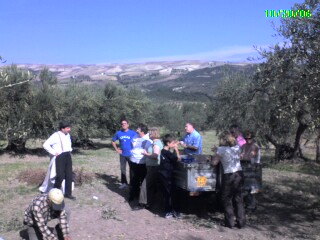
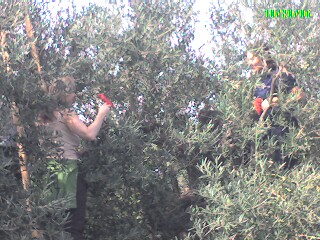
While the picking goes on, a picnic lunch is being assembled in the field by the families of Luigi and Giovanni. After a couple of hours of hard work, it is time to eat and there is a fabulous feast on the picnic blankets. Pizzas, salami, cheese, a frittata, olives, peppers, sausages, breads....in great abundance and all delicious. Of course, it all tastes even better after the olive picking. After grapes and cookies and pastries, the work resumes for a couple of hours......all is very convivial and friendly.
About 3 pm, we wrap up....all in all, 20 bags are picked (600 kilos) which will make 120 liters of Colletorto oil.
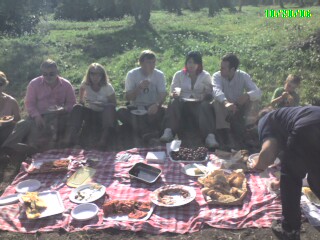
Some of the pickers walk back up the steep hill to town and others take a ride in our car which I bring back to serve as a shuttle service. We next visit the frantoio where the olives are brought to be processed and quickly turned into beautiful fresh green oil. The picked olives have to be crushed immediately so during the olive picking season, tractors and trucks line up outside the frantoios every afternoon and the mills run all night to finish the jobs. We watch the process (not our olives) from the beginning....the branches and large leaves are removed, the olives are washed, then ground into a paste. In the traditional process, the paste is extruded onto straw mats which are stacked and then put into hydraulic presses. The pressure is carefully controlled because it is important to avoid creating too much heat---the process is "cold pressing". It takes about 90 minutes to extract the oil and water from what is pressed....this liquid is put into a centrifuge and the water is separated from oil. The oil flows out--beautifully green--and is put into stainless steel drums until it is bottled or shipped off. We then go upstairs in the frantoio and are treated to a buffet of pizza, fruit, etc. but the highlight is to be able to dunk fresh bread into the new oil....which has a distinctive, deliciously rich peppery flavor.
Those who haven't been before continue on to a second frantoio which is much more modern and uses the newest technology. After the olives are dumped into the machinery, it is all automatically controlled. The oil is extracted from the olive paste using a centrifuge; there is no need to press the paste in the straw mats. According to our hosts, there is no difference in quality or quantity but the modern method is much less labor intensive. The town has 8 frantoios and it's fun to visit these two for contrast.
About 6 pm, we go back to the hotel to rest after the long day and to prepare for our next meal....dinner at 9 pm. Luigi has offered to let me hook up my computer to the telephone line at his family's house in town, so I walk over and--after a false start--get connected to the internet to check my e-mail.
We gather for drinks in the hotel bar prior to dinner....and then have another feast in the dining room. The menu includes a beautiful slice of prosciutto and some delicious mozzarella and sliced tomatoes. Following that is a bowl of pasta with beans and a second pasta--a wonderful spaghetti carbonara. The pastas are followed by a very tasty piece of veal milanese--pounded thin and delicately fried. Dessert is a light and refreshing fruit salad (macedonia) with a small scoop of gelato. The vino rosso della casa is very good and a great deal is consumed by the group. Everyone is having a wonderful time...talking and laughing. I had intended to go out to the bar with the rest of the younger crowd after dinner but when the meal is wrapping up at 11:30 pm, it is all I can do to climb the stairs and get into bed.
During dinner, Luigi tells us that he had seen on television the festivities that had taken place in San Giuliano earlier in the day. Former prime minister Silvio Berlusconi had been there campaigning for his candidate for regional president.
Tomorrow we are to have a road trip to the Adriatic coast town of Termoli and have lunch in a country restaurant.
After breakfast--a very nice spread of pastries, rolls, ham, yogurt, fruit and cakes--the weather appears to be improving. Luigi tells us that the plan is to wait for for a couple of hours for the fields to dry off...not only to avoid soggy ground but because picking when the trees are wet could damage them. While we wait, we walk up to the main street of the "village". In fact, Colletorto is more than a small village but is really a small town (certainly larger than Pienza). There are shops lining the main street and houses climb up the hill above the town and also down below the "centro". In the light of day, we notice two things that we had missed when we arrived last night. There is wooden and iron scaffolding supporting many of the buildings in town and there are a number of "temporary" buildings (large trailers) which house stores, bars and other shops. We find out that Colletorto is two miles from the town of San Giuliano di Puglia where 26 schoolchildren died in an earthquake just four years ago and, while there was no one killed in Colletorto, there was extensive damage that is still not repaired.
We stroll up and down the main street and into the old section with narrow lanes and a lot more scaffolding. We pass the very attractive city hall (municipio) with its open courtyard and the tall round medieval stone tower--the Torre Angioina--which seems to be closed for repairs. The hills surrounding the town are covered with olive trees--the main crop of Colletorto--and. across the valley, we can also see the town of San Giuliano di Puglia and "temporary" town of new wooden buildings close by. After our walk through town--there are groups of older men congregated on the street but very few women are out--the sun seems to be trying to break through and Luigi tells us that we will wait another hour and head to the fields at 11 am. We take the opportunity to drive over to San Giuliano di Puglia and see what we can see. We see a large number of construction vehicles along the road and several new houses being built on the hillsides between the two towns. The landscape looks quite stark and rugged....very brown and pretty steep.
The road into the village of San Giuliano is closed but we continue on to the temporary town....it is quite extensive with rows of nice wooden buildings for housing, a school, a commercial center and a large athletic field. The Molise regional elections are next week and election posters are plastered everywhere. We are surprised to see lines of television trucks from the Italian networks parked next to the town center and crowds of men in suits and in uniforms, but we don't have time to stop and find out what's going on.
By 11 am, the sun is out, the sky is blue and the temperature is very pleasant (in the low 70s). The group of 25 "workers" all walk together to the fields on the edge of Colletorto...the "weekender" participants are augmented by Luigi's sisters who usually return to Colletorto for the olive picking. Some of the participants have been coming back every year - others are newcomers, like us. They hail from Scotland, England and Wales, and are mostly colleagues and friends of Luigi, and then also friends of friends. One couple is here with two young boys. There are architects, educators, a fireman, an events planner - folks who are taking a break from their mostly high-pressured jobs to experience something altogether different in a very remote, beautiful spot. The equipment and a trailer full of refreshments are waiting for us, as well as the owner of the trees, and we get a quick orientation to our "jobs". In Molise, most olives are picked by hand because the fields are on hillsides and it is impossible to use mechanical equipment for the job. They also feel that the machines damage the trees. Large green nets are spread under the trees and pickers are armed with orange hand rakes (almost like large plastic combs). Some people climb ladders and other stay on the ground; the technique is to "comb" the olives off of the branches. They fall onto the netting and when the tree is finished, the olives are collected into bags and taken to the "frantoio". There is no need to discriminate between green and black olives....they are all mixed together. Leaves and twigs will also get separated out at the frantoio. When a tree is finished and the olives are bagged, the nets are moved over to another tree. Depending on the size of one's holdings, olives will be picked through November, with the frantoios running 24-7.



The work is not particularly onerous when the olives are at face level or below but when you have to reach above your head for branches, it can get tiring. Some of the "workers" spend time "guarding" the refreshment trailer and handing out drinks to those who are picking.


While the picking goes on, a picnic lunch is being assembled in the field by the families of Luigi and Giovanni. After a couple of hours of hard work, it is time to eat and there is a fabulous feast on the picnic blankets. Pizzas, salami, cheese, a frittata, olives, peppers, sausages, breads....in great abundance and all delicious. Of course, it all tastes even better after the olive picking. After grapes and cookies and pastries, the work resumes for a couple of hours......all is very convivial and friendly.
About 3 pm, we wrap up....all in all, 20 bags are picked (600 kilos) which will make 120 liters of Colletorto oil.

Some of the pickers walk back up the steep hill to town and others take a ride in our car which I bring back to serve as a shuttle service. We next visit the frantoio where the olives are brought to be processed and quickly turned into beautiful fresh green oil. The picked olives have to be crushed immediately so during the olive picking season, tractors and trucks line up outside the frantoios every afternoon and the mills run all night to finish the jobs. We watch the process (not our olives) from the beginning....the branches and large leaves are removed, the olives are washed, then ground into a paste. In the traditional process, the paste is extruded onto straw mats which are stacked and then put into hydraulic presses. The pressure is carefully controlled because it is important to avoid creating too much heat---the process is "cold pressing". It takes about 90 minutes to extract the oil and water from what is pressed....this liquid is put into a centrifuge and the water is separated from oil. The oil flows out--beautifully green--and is put into stainless steel drums until it is bottled or shipped off. We then go upstairs in the frantoio and are treated to a buffet of pizza, fruit, etc. but the highlight is to be able to dunk fresh bread into the new oil....which has a distinctive, deliciously rich peppery flavor.
Those who haven't been before continue on to a second frantoio which is much more modern and uses the newest technology. After the olives are dumped into the machinery, it is all automatically controlled. The oil is extracted from the olive paste using a centrifuge; there is no need to press the paste in the straw mats. According to our hosts, there is no difference in quality or quantity but the modern method is much less labor intensive. The town has 8 frantoios and it's fun to visit these two for contrast.
About 6 pm, we go back to the hotel to rest after the long day and to prepare for our next meal....dinner at 9 pm. Luigi has offered to let me hook up my computer to the telephone line at his family's house in town, so I walk over and--after a false start--get connected to the internet to check my e-mail.
We gather for drinks in the hotel bar prior to dinner....and then have another feast in the dining room. The menu includes a beautiful slice of prosciutto and some delicious mozzarella and sliced tomatoes. Following that is a bowl of pasta with beans and a second pasta--a wonderful spaghetti carbonara. The pastas are followed by a very tasty piece of veal milanese--pounded thin and delicately fried. Dessert is a light and refreshing fruit salad (macedonia) with a small scoop of gelato. The vino rosso della casa is very good and a great deal is consumed by the group. Everyone is having a wonderful time...talking and laughing. I had intended to go out to the bar with the rest of the younger crowd after dinner but when the meal is wrapping up at 11:30 pm, it is all I can do to climb the stairs and get into bed.
During dinner, Luigi tells us that he had seen on television the festivities that had taken place in San Giuliano earlier in the day. Former prime minister Silvio Berlusconi had been there campaigning for his candidate for regional president.
Tomorrow we are to have a road trip to the Adriatic coast town of Termoli and have lunch in a country restaurant.
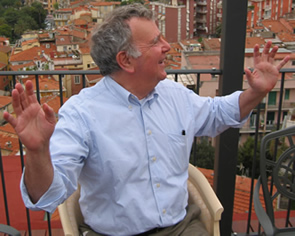

1 Comments:
hey!!
We want too this olive picking job can u help us? Can you tell us where we can find this kind of job and soo...
please write me soon in my email Katriin151@hot.ee
Post a Comment
<< Home